Review: Schaefer 510GTS Yacht
Schaefer Yachts are designed and manufactured in Brazil.
Derided in childhood ‘Biggles’ books as, “the place where nuts come from and nuts go to”, Brazil has a GDP larger than Australia’s and the country is a major food and manufactured goods exporter — examples are Mercedes-Benz and VW automobiles, and Schaefer Yachts.
Schaefer Yachts’ 510GTS is the latest iteration of the Sport 51ft family that was released in 2017. Our test boat featured the company’s three-cabin, three-head internal fit-out that offers generous below decks accommodation for a big sports cruiser.
The Builder
Founded in 1992 by yacht designer Márcio Schaefer, Schaefer Yachts is the builder of world-class luxury sport yachts up to 25m in length. In late 2016, Schaefer signed an ongoing styling agreement with Italian design studio, Pininfarina, famous for designing some of the world’s most beautiful Ferrari cars and in 2018 released an intriguing ‘wheel-less’, joystick-only 580 model.
The company employs more than 1000 specialists and uses state-of-the-art production equipment, exemplified by a giant Bermaq SG-22 computer-controlled milling machine. This five-axis machine produces precision boat plugs, from which highly accurate moulds are made.
The shipyard also uses vinyl ester resins in state-of-the-art vacuum infusion equipment, which makes the boats lighter and more robust than polyester construction. The main powertrain supplier is Volvo Penta and Onan turns diesel into electricity.
Construction
From the drawing board — or, more appropriately these days, CAD-CAM screen — the 510 sports and flybridge models are based around the Volvo Penta IPS pod-drive system. In the case of this hull, the IPS orientation goes as far as realigning conventional engine positioning.
Twin-engine installations normally have the engines set beside each other on parallel bearers that align with the keel, but the Schaefer 510 has the engine bearers slightly inclined towards each other at their forward ends. This orientation narrows the forward width of each engine, allowing ample working space and also providing additional hull space for a small port-side ‘crew’ cabin and an 11.5kVA, starboard-side, Onan generator.
Narrowing the engine-space width also gives more hull-shape freedom and the Shaefer 510 has a deadrise of 17 degrees at the transom — a compromise between seagoing ability and hull volume.
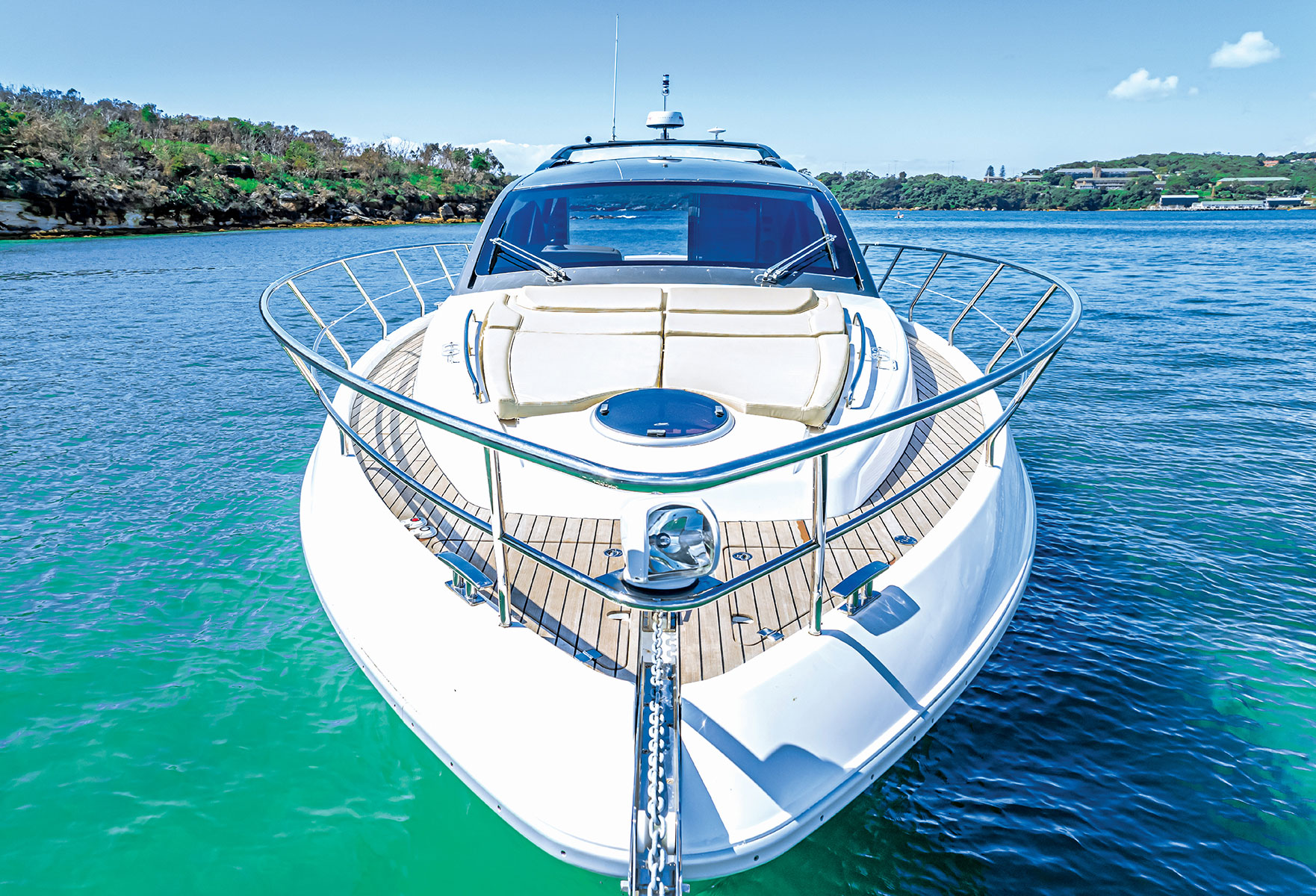
Our test boat was powered by a pair of 550hp Volvo Penta D8-IPS700 7.7L, common-rail diesel engines, with twin-entry turbos and superchargers. They were coupled to IPS15 pods with twin counter-rotating propeller legs and Volvo Penta’s excellent Electronic Vessel Control systems.
Setting Off
Our dockside inspection of the 510GTS began in the interesting engine room, where we found servicing access straightforward and labelling of critical components very good. (The USA is Schaefer’s largest export market, so English instructions have received priority.)
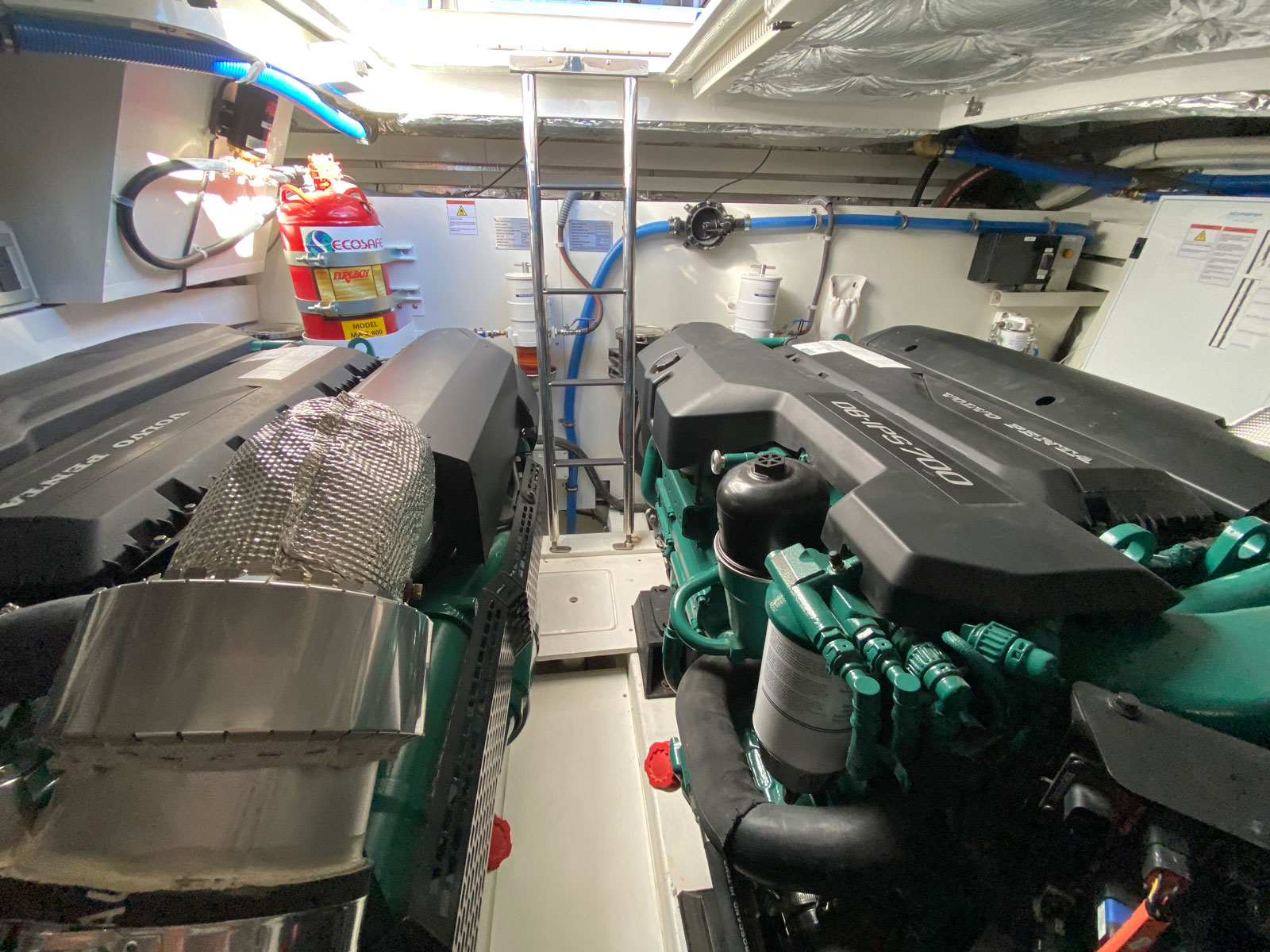
Access to the engine bay was via an aft deck hatch, but it was interesting to note a much larger deck panel that could be removed, without cutting into the teak planking, should it be necessary to extract the generator or an engine.
Getting aboard from a pontoon dock meant a same-level step onto the huge swim platform, but this platform raised and lowered electro-hydraulically, so dock variance was easy to adjust for.
The swim platform is notable for incorporating teak steps that provided safe access from the aft deck. As the platform lowered, the staircase emerged and the steps remained horizontal, regardless of the platform height. It also has a load rating of 160kg, so strapping a tender or a few water toys in place wouldn’t be a problem.
On the aft deck, two steps down from the saloon deck, is a large BBQ module, with an electric-element, hot-rock cooker and is flanked by twin ice boxes sitting atop a pair of large storage bins.
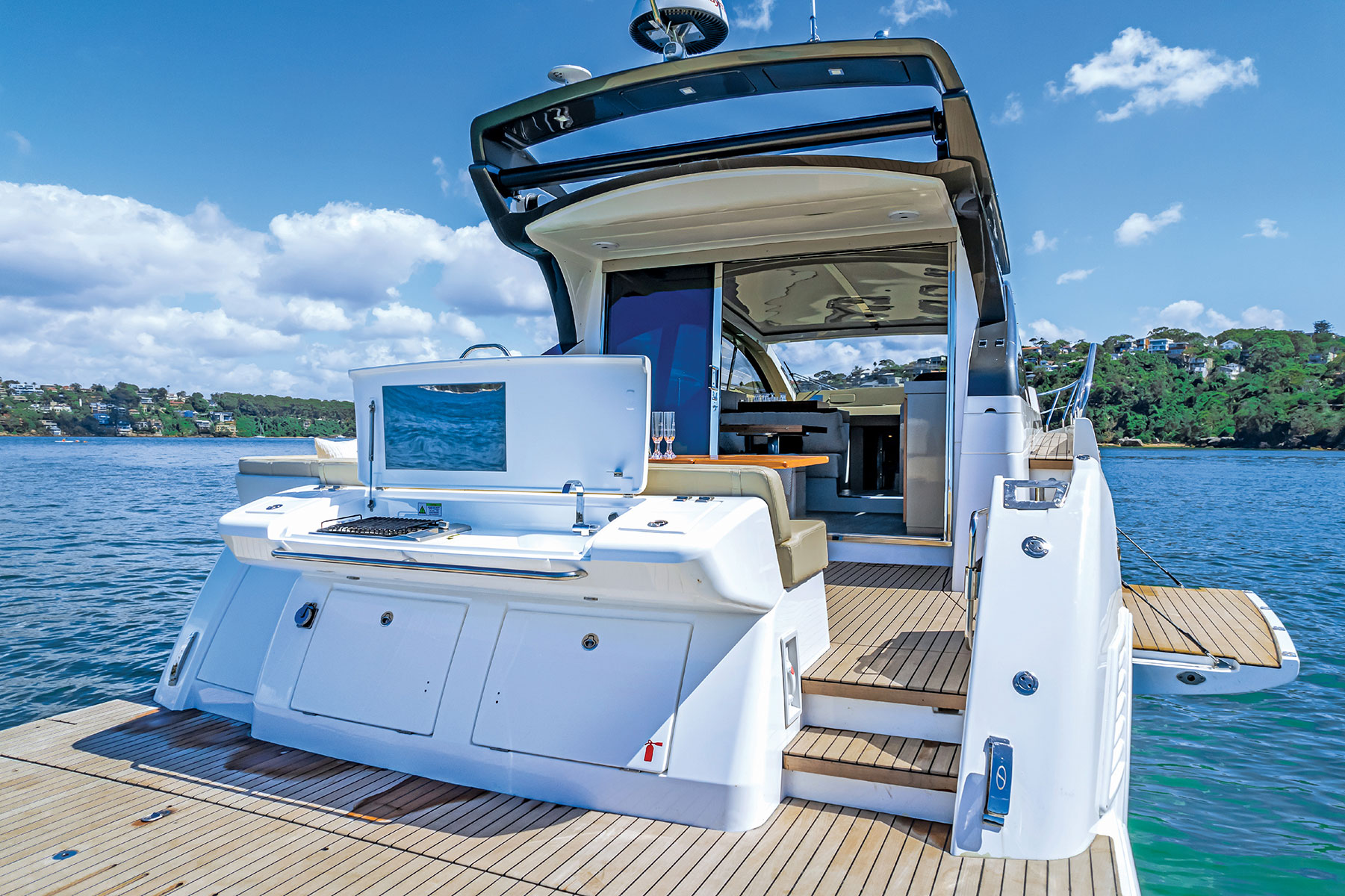
The teak-planked saloon deck features an L-shaped lounge and extendable centre-pedestal table. It also had an inwale section that lowered electrically to become a side balcony. To its side, a remote joystick control panel allowed easy docking from the boat’s starboard quarter.
A powered sun awning extends over part of the saloon deck, from the aft end of the carbon-fibre targa roof.
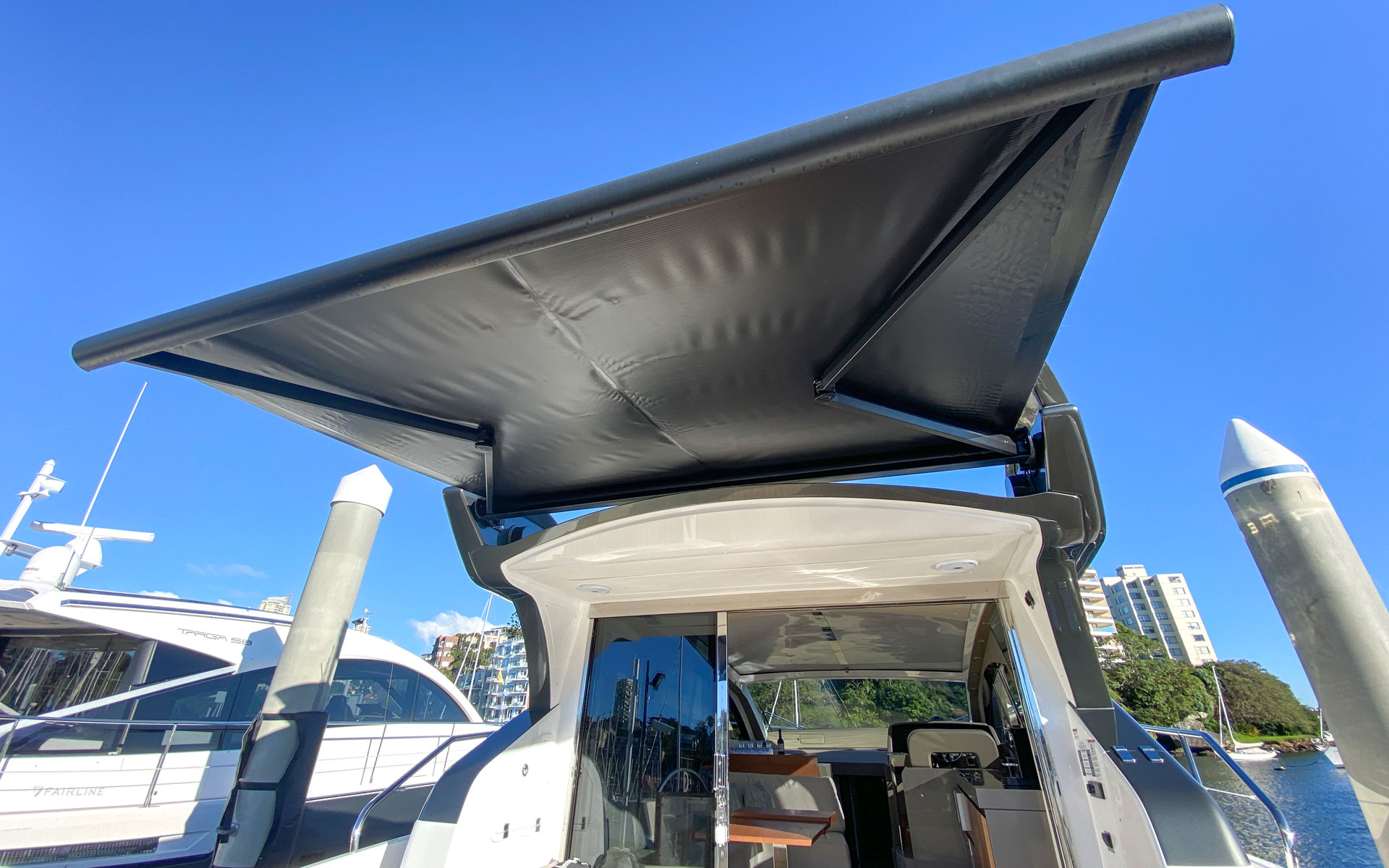
Also on the saloon deck is a covered companionway, leading into a small ‘crew’ cabin that features a single bed, sink and toilet. I reckon kids would love this hideaway if the boat wasn’t crewed, but it could also be used for storage space.
The Interior
Three-part, sliding stainless-framed glass doors separate the saloon from the flush-deck area. Removable carpet covered the FRP saloon sole and FRP interior flooring, giving apartment-like underfoot comfort and encouraging visitors to go barefoot indoors.
‘Apartment-like’ is certainly the Italian design theme of the saloon and the below-deck cabins. Cream leather trim, soft wall coverings and gloss-grey lacquer gave a luxurious feel and are, I think, a better choice for the Australian market than the somewhat garish, diamond-pleat leather and blue-highlight trim used on some US-market boats.
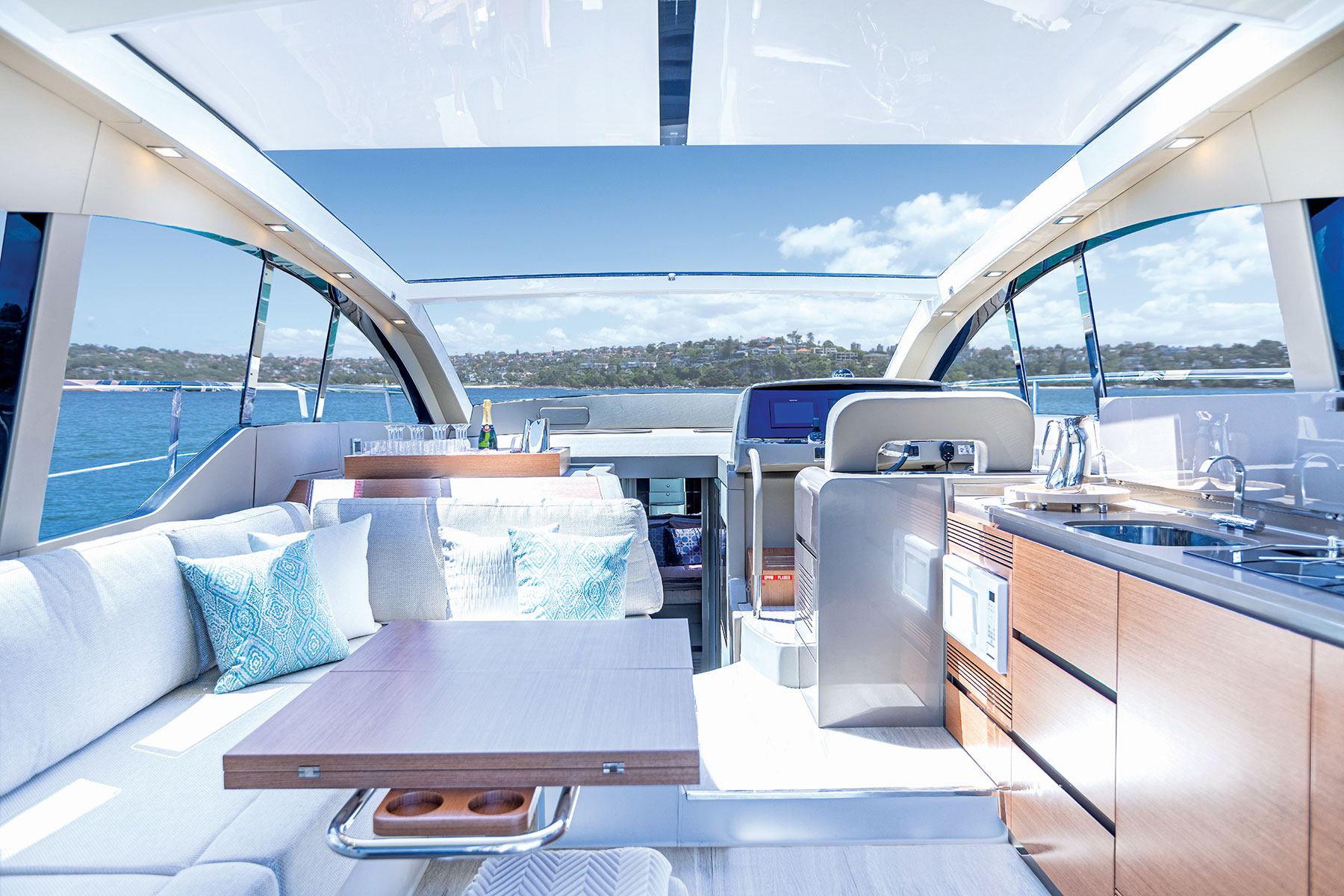
A large sink complemented by a folding mixer tap and an electric induction cooktop with adjustable pot fiddles hides beneath grey-lacquered lids along the starboard side. To celebrate a culinary success, a U-shaped lounge and extendable table are opposite. Drawers and cupboards throughout the boat had push-action, hidden catches, a nice level of sophistication.
An oven and microwave are found under the Silestone bench, and two fridges are hidden behind cupboard doors. I feel the fridges could have been larger, but maybe the Brazilians don’t drink as much beer as my mates!
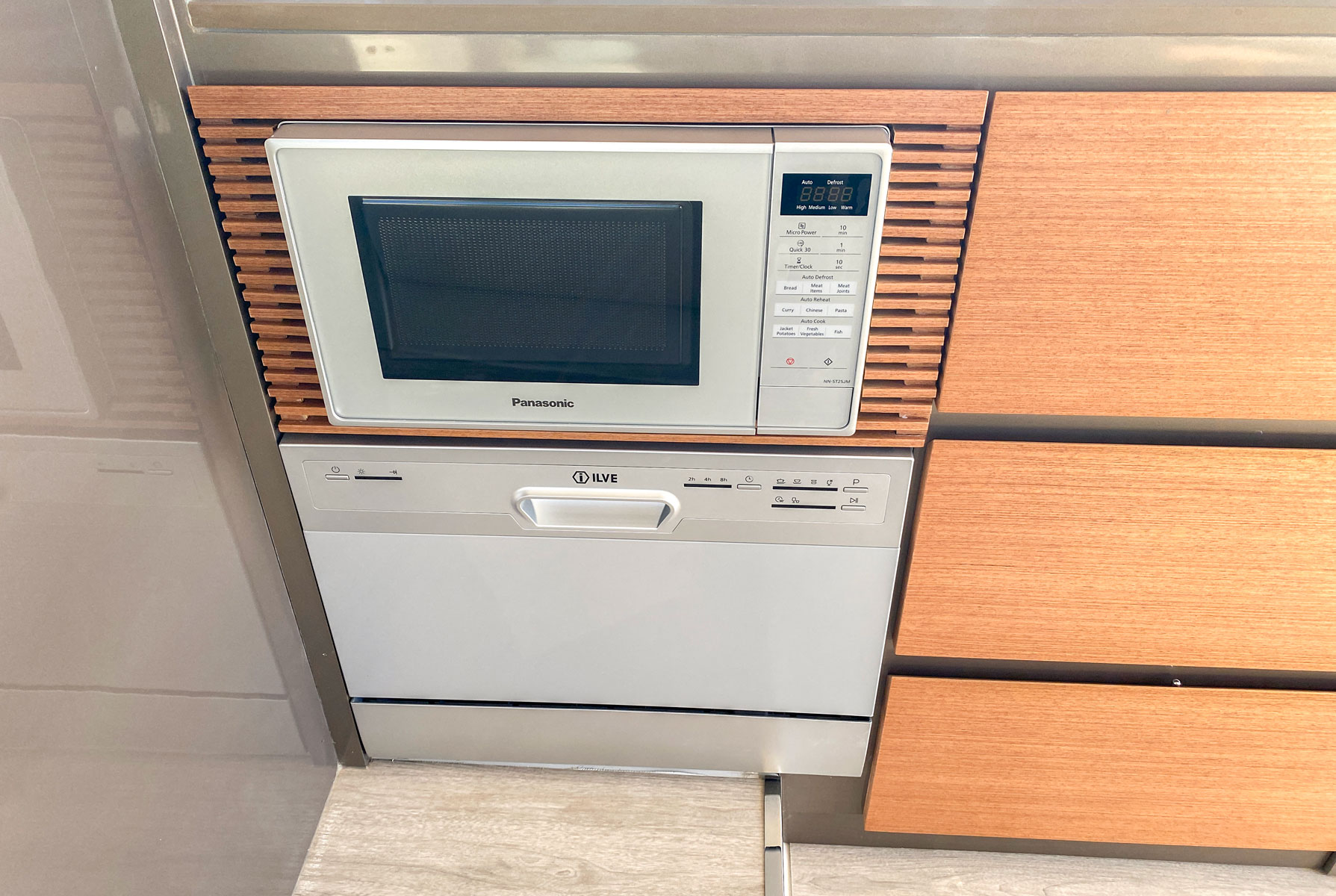
Schaefer claimed the boat is intended for up to 16 people for day cruises and they’d easily be seated on the lounges and a few deck chairs.
At the forward end of the saloon, the starboard steering station is purposefully narrow - although comfy for two really good friends — to maximise saloon and companionway space. A design element I appreciate is pull-out panels that give quick access to the windscreen wiper motors and the behind-dashboard electronic connections.
The helmsperson has adjustable seating and a clear view of three display screens, with the standard IPS joystick control, engine speed levers and essential function rocker switches close to hand. The small, leather-trimmed, car-like steering wheel is well-positioned. The entire saloon roof could be opened quickly to the sky, extending the open-air feel of the boat.

Schaefer offers three 510 cabin options: a two-bedroom, two-head, with two common areas; a two-bedroom, two-head with central common area and a three-bedroom, three-head arrangement. The test boat has a three-cabin layout that I thought might be somewhat cramped but turned out to be quite habitable. In this layout, the forward head doubles as a day-head and the central cabin has two single beds.
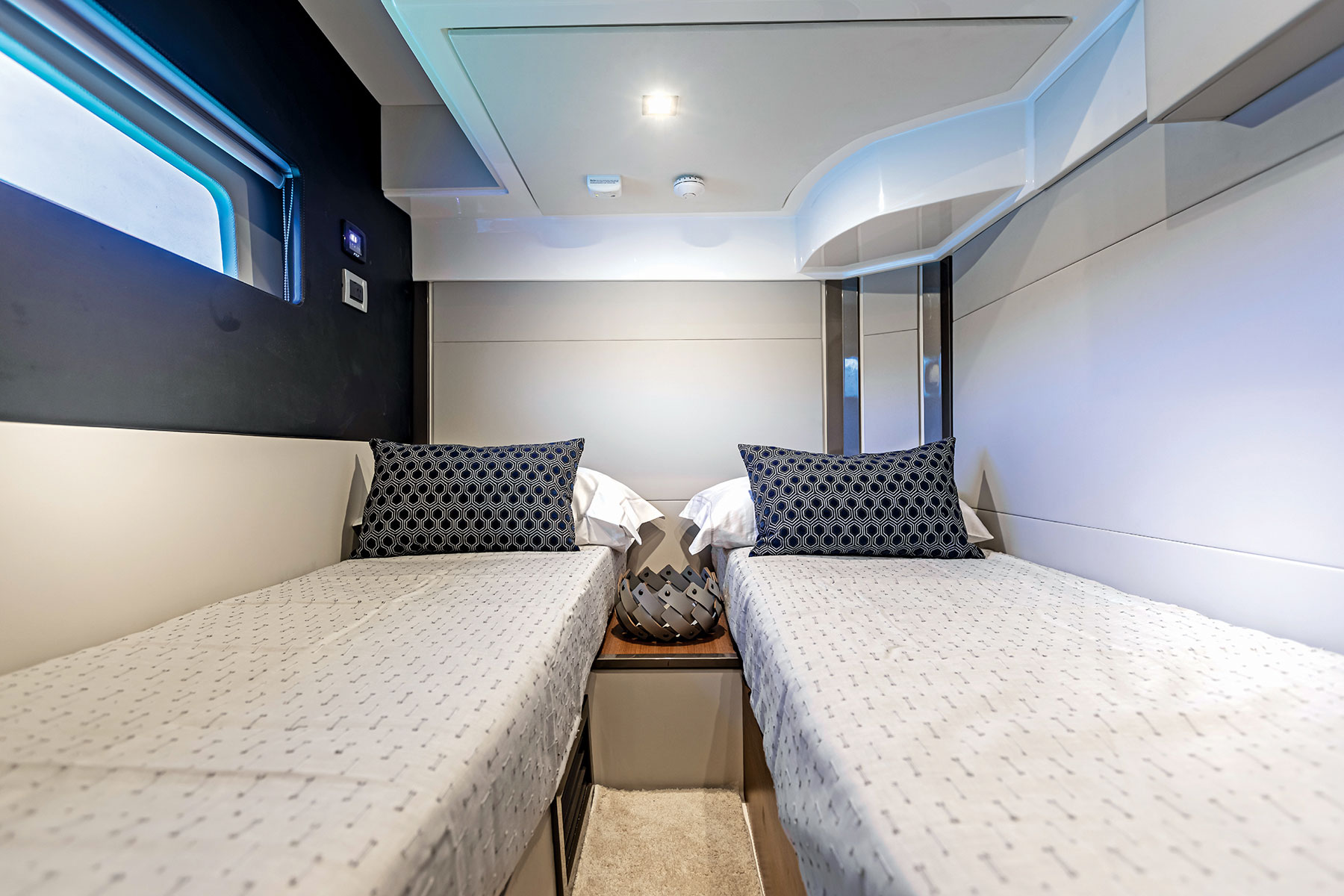
In all options, the forward and aft cabins have queen-sized island beds, and the aft cabin also has a lounge. The sunken aft cabin is the largest but is also closest to the engine firewall so would perhaps not be the most relaxing. Sleeping in this cabin with the generator running, to operate the air conditioning, wouldn’t be a problem for me, but sensitive souls might prefer the forward cabin. In the right weather, of course, all cabins have opening ports, set into bonded glazed hull panels.
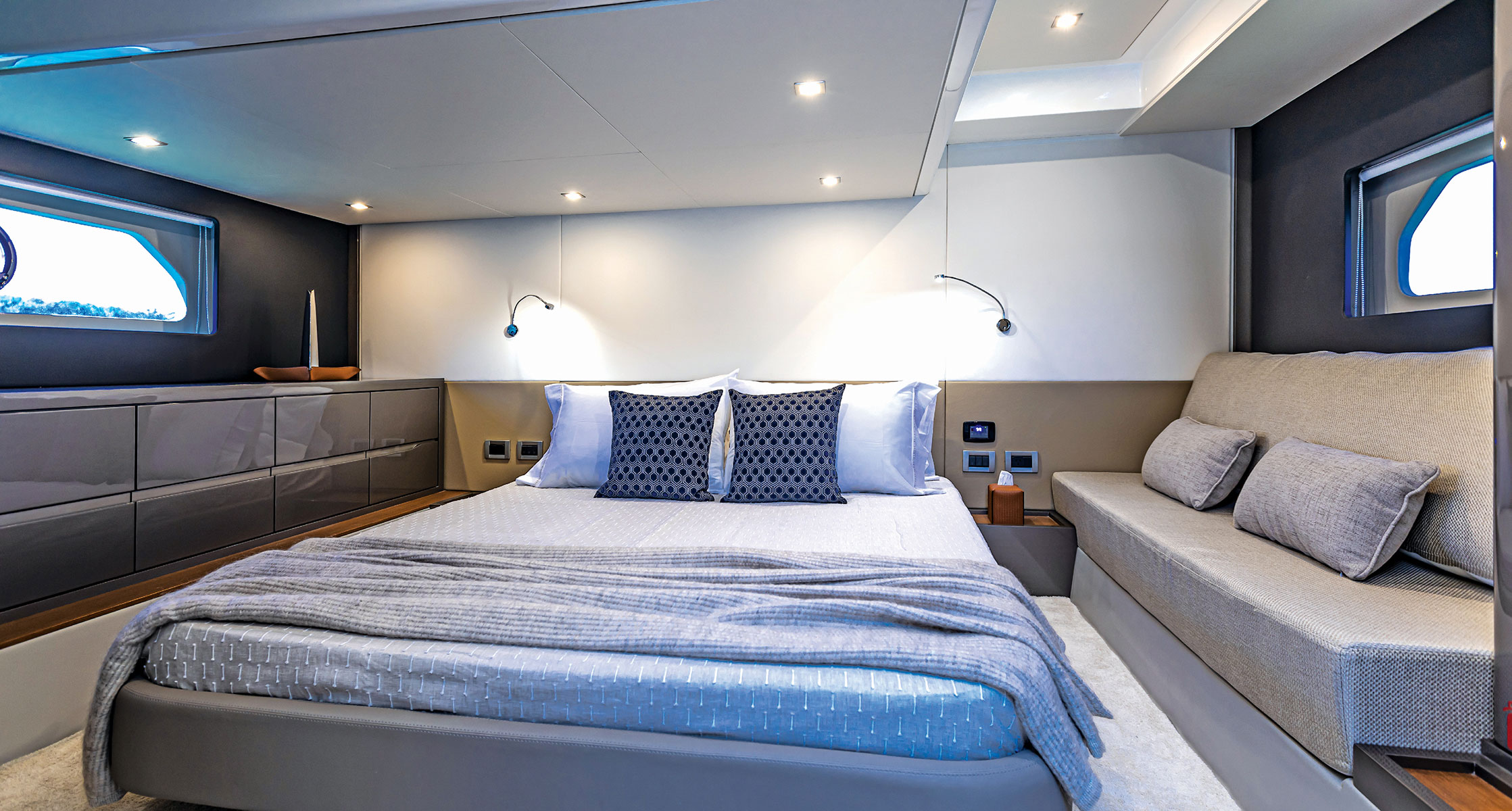
With the aircon, cooking, refrigeration, water heating, four TVs, awning, four bilge pumps, four flushing toilets, anchor windlass and powered decks being all-electric the Schaefer 510GTS was well equipped with batteries — one 150Ah 12V each for engine starting and a total of six 12V house batteries totalling 695Ah which should allow for a reasonable amount of use without firing up the Onan.
The hot water system is also electric but can have input from engine coolant transfer while the engines are operating to reduce electrical load.
Underway
My short evaluation of the Schaefer 510GTS was conducted on Sydney Harbour, on a rare, sunny autumn day, with enough through-heads swell and cross-breeze to set up some typical chop.
The boat cut a stunning picture, thanks to its blue-white, two-tone colour scheme. The dark blue hull colour disguised the glazed hull inserts and also reduced the visual height of the 510GTS giving it a real sense of purpose and speed.
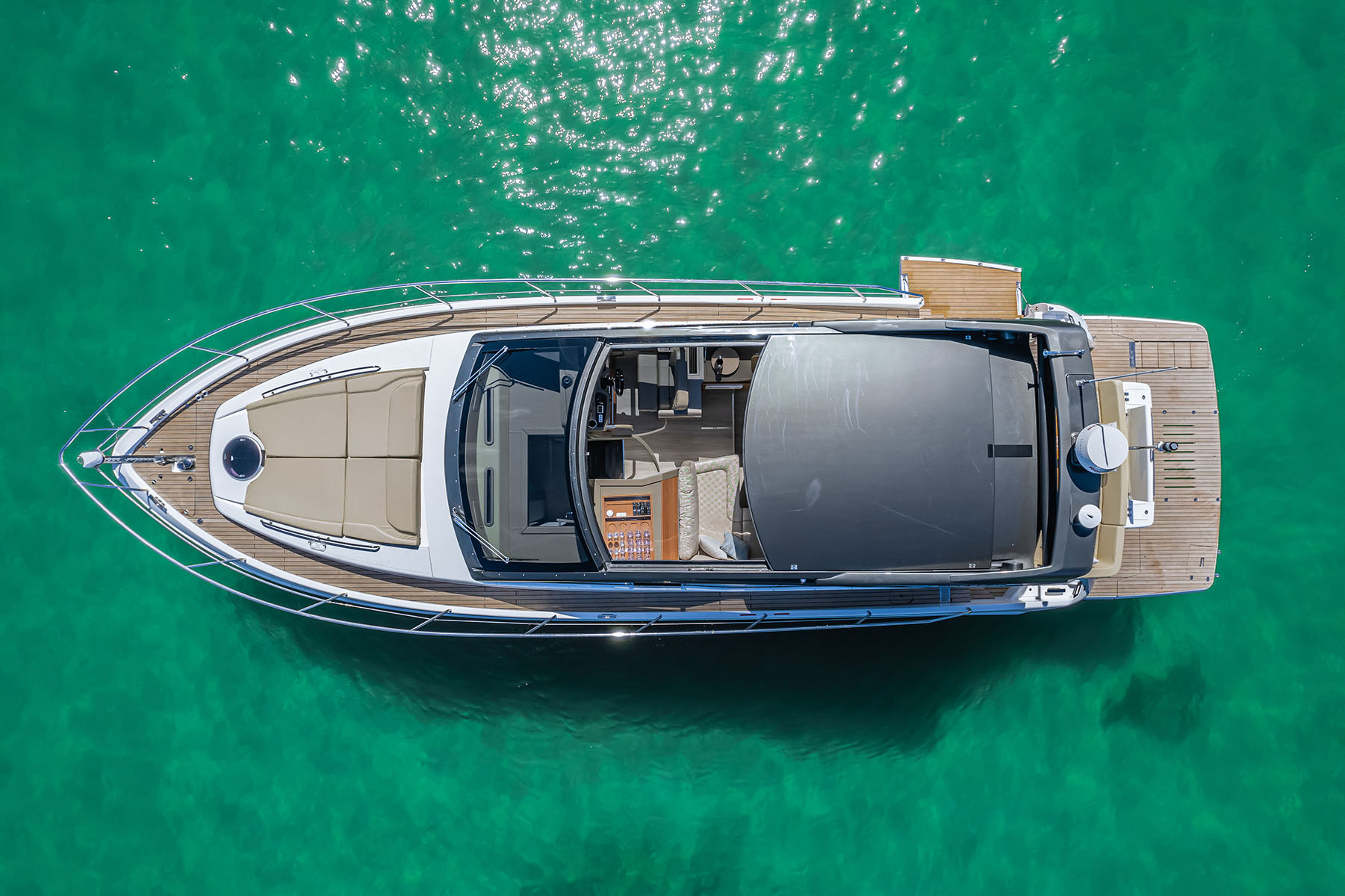
Two-up manoeuvring out of a very tight d’Albora Marina berth was eased immensely by the IPS joystick control, allowing unfussed mooring rope handling. Powered side windows at the steering station allow easy communication between crew and helm person.
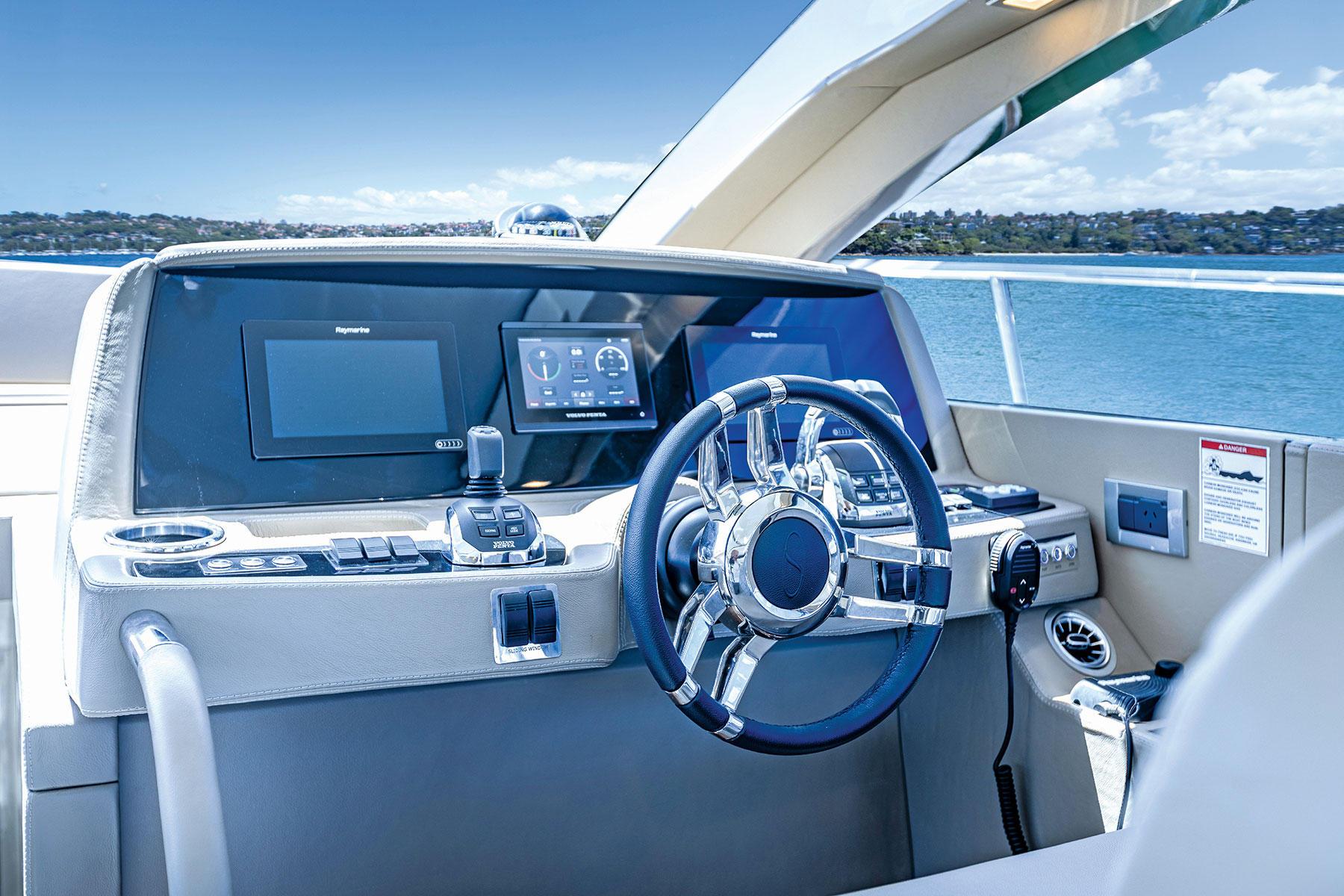
Once clear of no-wash areas the softly burbling diesels were unleashed, with common-rail injection, low-rev supercharging and high-rev turbocharging doing their part to see planing speed achieved in around eight seconds.
The hull feels effortless the steering wheel action is precise, with no delay in response. Handling is excellent. With the sliding roof opened there was fresh-air flow, but no wind buffeting.
Schaefer claims a cruising speed of around 24 knots, but the ‘sweet spot’ in this particular boat was around four knots lower than that, with a fuel burn in each engine showing 130L/h.
WOT operation registered a shade over 27 knots, but should be 32 knots, according to Schaefer’s specs. Overseas independent testing has confirmed Shaefer’s claimed figures, with several recordings of 32.5 knots at 2800rpm.
A closer inspection of our test boat’s hull showed considerable shell build-up, following Sydney’s wet, warm-water summer. Schaefer Yachts Australia’s national sales manager, Drew Watney, told me that the clean-bottom boat had easily achieved 32 knots out of the box.
The Wrap
With its deck and saloon spaces devoted to entertainment and having limited water and fuel tankage, the Schaefer 501GTS is aimed at the short-haul recreational market. With a generous ‘party room’, huge foredeck sun lounge, ease of safe swimming access and overnight accommodation for up to six people, it fits that bill.
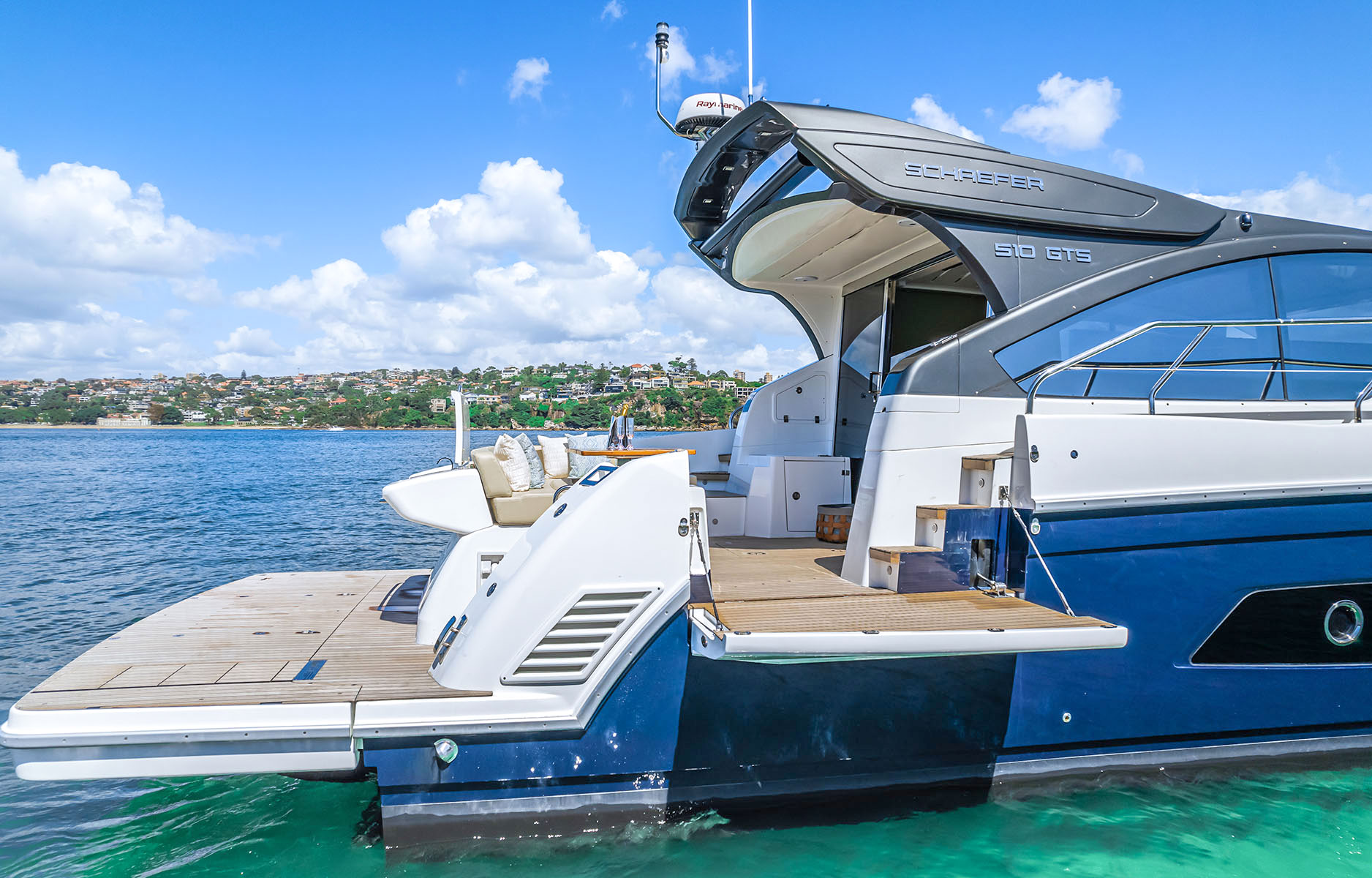
Considering its styling, performance, ergonomics, equipment levels and fit and finish, this boat offers good value for money and a brand that will lead the conversation through its design and origin while being backed with reputable powertrain suppliers to give you confidence it’ll perform as good as it looks.
Schaefer 501GTS General Specs
| Material | Vinylester GRP and carbon fibre |
| Type | Sport cruiser |
| Length | 15.82 M (51ft 9in) |
| Beam | 4.36 M (14ft 3in) |
| Max Draft | 1.26M (4ft 2in) |
| Weight | 18.3 T |
| People Capacity | 16 (day) 6 (night) + 1 crew |
| Fuel | 1300 L |
| Water | 470 L |
Engine
| Make/Model | Twin Volvo D8-IPS 700 |
| Type | Six-cylinder turbo diesel with twin entry turbo and supercharger |
| Rated HP | 550hp (410kW) |
| Displacement | 7.7 L |
| Weight | 1410 KG (inc propellers) |
| Gear Ration | N/A |
| Propeller | Counter Rotating Duo Props |
Priced from $2.06m
Option Fitted N/A
Price as tested $2.06m
Supplied by Schaefer Yachts Australia
